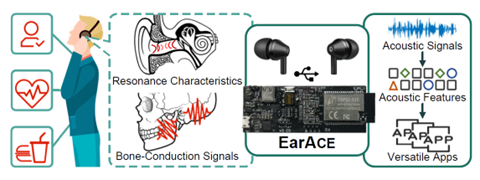
EarPCG: Fine-Grained Heartbeat Waveform Extraction With ANC-Based Earable Sensing
Synopsis
This invention introduces EarPCG—the first acoustic sensing platform exploiting the native acoustics of commercial active noise cancellation (ANC) earphones. Leveraging a systematic study on in-ear acoustic signals, EarAce combats performance sensitivity to device wearing states and eliminates body motion interference.
Opportunity
Earable computing offers a new modality of hands-free sensing and low-intrusive information exchange, revolutionising human wearable computing. While progress has been achieved in human-computer interaction and context-aware computations, dedicated earable sensors are expensive and inflexible. Leveraging low-cost, ubiquitous ANC earphones can overcome these limitations.
The increasing demand for natural communication experiences and awareness of noise-induced hearing loss have led to a rise in ANC earphones’ market share. These devices’ high-standard in-ear acoustic facilities, such as microphones, can significantly improve existing earable sensing capabilities. However, many proposals for ANC earphones lack well-engineered construction, limiting their practical effectiveness. Flexible access to the native acoustics of ANC earphones is essential to advance earable acoustic sensing without the need for repetitive hardware prototype building.
Technology
EarPCG is the first earable ANC platform leveraging the native acoustics of commercial ANC earphones for versatile acoustic sensing. Human vital signals propagate to the ears through bones, creating unique ear canal resonance characteristics. EarPCG captures these signals with ANC in-ear microphones, enabling versatile sensing functionalities. The platform design minimises hardware heterogeneity adaptations. An Android-based control interface allows users to configure platform parameters and access sensing data. To address device wearing states (DWSs) affecting sensing quality, EarPCG profiles their impacts using an impedance indicator, enabling the detection of fine-grained DWSs. To mitigate body motion interference, EarPCS harnesses the different acoustic characteristics between left and right ears, using path sensitivity and non-periodicity of interference to enable an elimination algorithm for reliable sensing in real-life scenarios.

Figure 1: The conceptual construction of EarPCG: it leverages the in-ear microphone equipped with ANC (active noise cancellation) earphones to capture the PCG (acoustic signals produced by heartbeats) transferred to ears via human body.

Figure 2: Snapshots of PCG under the four cases (left ear) and two baselines, with interferences of walking highlighted with red dotted lines. Case i indicates the performance of EarPCG.
Applications & Advantages
Main application areas include the continuous monitoring of physiological signals, particularly heart sounds, or phonocardiograms (PCG), and user authentication.
Advantages:
- Versatile acoustic sensing using commercial ANC earphones
- Continuous monitoring of physiological signals including heart sounds (PCGs)
- Reliable user authentication through biometric PCG
- Overcomes performance sensitivity to device wearing states
- Eliminates body motion interference with advanced algorithms


.tmb-listing.jpg?Culture=en&sfvrsn=8fcd2938_1)












